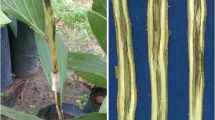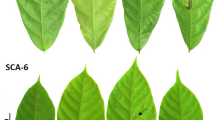Abstract
Two reliable small-plant bioassays were developed using tissue-cultured banana, resulting in consistent symptom expression and infection by Fusarium oxysporum f. sp. cubense (Foc). One bioassay was based on providing a constant watertable within a closed pot and the second used free-draining pots. Culture medium for spore generation influenced infectivity of Foc. Inoculation of potted banana by drenching potting mix with a conidial suspension, consisting mostly of microconidia, few macroconidia and no chlamydospores, generated from one-quarter-strength potato dextrose agar + streptomycin sulfate, resulted in inconsistent infection. When a conidial suspension that consisted of all three spore types, microconidia, macroconidia and chlamydospores, prepared from spores generated on carnation leaf agar was used, all plants became infected, indicating that the spore type present in conidial suspensions may contribute to inconsistency of infection. Inconsistency of infection was not due to loss of virulence of the pathogen in culture. Millet grain precolonised by Foc as a source of inoculum resulted in consistent infection between replicate plants. Sorghum was not a suitable grain for preparation of inoculum as it was observed to discolour roots and has the potential to stunt root growth, possibly due to the release of phytotoxins. For the modified closed-pot system, a pasteurised potting mix consisting of equal parts of bedding sand, perlite and vermiculite plus 1 g/L Triabon slow release fertiliser was suitable for plant growth and promoted capillary movement of water through the potting mix profile. A suitable potting mix for the free-draining pot system was also developed.
Similar content being viewed by others
References
Awuah RT, Lorbeer JW (1988) Nature of cultural variability in Fusarium oxysporum f. sp. apii Race 2. Phytopathology 78, 385–389. doi: 10.1094/Phyto-78-385
Bancroft J (1876) Report of the board appointed to enquire into the cause of disease affecting livestock and plants. In ‘Votes and proceedings 1877. Vol. 3, Queensland’. pp. 1011–1038.
Beckman C, Roberts E (1995) On the nature and genetic basis for resistance and tolerance to fungal wilt diseases of plants. Advances in Botanical Research 21, 35–77.
Bugbee WM, Sappenfield WP (1968) Varietal reaction of cotton after stem or root inoculation with Fusarium oxysporum f. sp. vasinfectum. Phytopathology 58, 212–214.
Burgess LW, Summerell BA, Bullock S, Gott KP, Backhouse D (1994) ‘Laboratory manual for Fusarium research.’ 3rd edn. (University of Sydney: Sydney)
Couteaudier Y, Alabouvette C (1990) Survival and inoculum potential of conidia and chlamydospores of Fusarium oxysporum f. sp. lini in soil. Canadian Journal of Microbiology 36, 551–556.
Dhingra OD, Sinclair JB (1995) ‘Basic plant pathology methods.’ 2nd edn. (CRC Press: Boca Raton, FL)
Duniway J (1971) Water relations of Fusarium wilt of tomato. Physiological Plant Pathology 1, 537–546.
Einhellig FA, Rasmussen JA (1989) Prior cropping with grain sorghum inhibits weeds. Journal of Chemical Ecology 15, 951–960. doi: 10.1007/BF01015190
Einhellig FA, Souza IF (1992) Phytotoxicity of sorgoleone found in grain sorghum root exudates. Journal of Chemical Ecology 18, 1–11. doi: 10.1007/BF00997160
Forney DR, Foy CL, Wolf DD (1985) Weed suppression in no-till alfalfa (Medicago sativa) by prior cropping of summer-annual forage grasses. Weed Science 33, 490–497.
Gracia-Garza JA, Fravel DR (1998) Effect of relative humidity on sporulation of Fusarium oxysporum in various formulations and effect of water on spore movement through soil. Phytopathology 88, 544–549. doi: 10.1094/PHYTO.1998.88.6.544
Gramss G (1991) ‘Definitive senescence’ in stock cultures of basidiomycetous wood-decay fungi. Journal of Basic Microbiology 31, 107–112. doi: 10.1002/jobm.3620310207
Guenzi WD, McCalla IN (1966) Phenolic acids in oats, wheat, sorghum and corn residues and their phytotoxicity. Agronomy Journal 58, 303–304.
Hartman GL, Noel GR, Gray LE (1995) Occurrence of soybean death syndrome in east-central Illinois and associated yield losses. Plant Disease 79, 314–318.
Hwang S, Ko W (2004) Cavendish banana cultivars resistant to Fusarium wilt acquired through somaclonal variation in Taiwan. Plant Disease 88, 580–588. doi: 10.1094/PDIS.2004.88.6.580
Katan T, Shlevin E, Katan J (1997) Sporulation of Fusarium oxysporum f. sp. lycopersici on stem surface of tomato plants and aerial dissemination of inoculum. Phytopathology 87, 712–719. doi: 10.1094/PHYTO.1997.87.7.712
Mackauer M (1976) Genetic problems in the production of biological control agents. Annual Review of Entomology 21, 369–385. doi: 10.1146/annurev.en.21.010176.002101
Marois JJ (1990) Biological control of diseases caused by Fusarium oxysporum. In ‘Fusarium wilt of banana’. (Ed. RC Ploetz) pp. 74–81. (The American Phytopathological Society Press: St Paul, MN)
Morrow BJ, Boucias DG, Heath MA (1989) Loss of virulence in an isolate of an entomopathogenic fungus, Nomuraea rileyi, after serial in vitro passage. Journal of Economic Entomology 82, 404–407.
Nash SM, Christou T, Snyder WC (1961) Existence of Fusarium solani f. phaseoli as chlamydospores in soil. Phytopathology 51, 308–312.
Nelson P (1981) Life cycle and epidemiology of Fusarium oxysporum. In ‘Fungal wilt diseases of plants’. (Eds ME Mace, AA Bell, CH Beckman) pp. 51–80. (Academic Press: New York)
Newcombe G, Lee B, Robb J (1990) Early vascular sporulation: a possible role in the virulence of Verticillium albo-atrum in wilt of alfalfa. Physiological and Molecular Plant Pathology 36, 441–449. doi: 10.1016/0885-5765(90)90017-R
Nowak J (1998) Benefits of in vitro ‘biotization’ of plant tissue cultures with microbial inoculants. In Vitro Cellular & Developmental Biology 34, 122–130.
Nyvall RF, Haglund WA (1972) Sites of infection of Fusarium oxysporum f. pisi Race 5 on peas. Phytopathology 62, 1419–1424.
Orjeda G (1998) ‘Evaluation of Musa germplasm for resistance to Sigatoka diseases and Fusarium wilt.’ (INIBAP — International Plant Genetic Resources Institute: Rome)
Pegg K, Moore N, Bentley S (1996) Fusarium wilt of banana in Australia: a review. Australian Journal of Agricultural Research 47, 637–650. doi: 10.1071/AR9960637
Ploetz RC, Herbert J, Sebasigari K, Hernandez JH, Pegg KG, Ventura JA, Mayato LS (1990) Importance of Fusarium wilt in different bananagrowing regions. In ‘Fusarium wilt of banana’. (Ed. RC Ploetz) pp. 9–26. (The American Phytopathological Society Press: St Paul, MN)
Pospíšilová J, Tichá I, Kadleček P, Haisel D, Plazakova Š (1999) Acclimatization of micropropagated plants to ex vitro conditions. Biologia Plantarum 42, 481–497. doi: 10.1023/A:1002688208758
Putnam AR, DeFrank J (1983) Use of phytotoxic plant residues for selective weed control. Crop Protection 2, 173–181. doi: 10.1016/0261-2194(83)90042-X
Rekah Y, Shtienberg D, Katan J (2000) Disease development following infection of tomato and basil foliage by airborne conidia of the soilborne pathogens Fusarium oxysporum f. sp. radicislycopersici and F. oxysporum f. sp. basilici. Phytopathology 90, 1322–1329. doi: 10.1094/PHYTO.2000.90.12.1322
Rishbeth J (1955) Fusarium wilt of bananas in Jamaica. I. Some observations on the epidemiology of the disease. Annals of Botany 19, 293–329.
Rowe RC, Farely JD, Coplin DC (1977) Airborne spore dispersal and recolonization of steamed soil by Fusarium oxysporum in greenhouses. Phytopathology 67, 1513–1517.
Schippers B, Van Eck WH (1981) Formation and survival of chlamydospores in Fusarium. In ‘Fusarium, diseases, biology and taxonomy’. (Eds PE Nelson, TA Tousson, RJ Cook) pp. 250–260. (The Pennsylvania State University Press: University Park, PA)
Smith LJ (2006) Developing healthier banana roots with mycorrhizae and rhizobacteria. PhD Thesis, School of Agronomy and Horticulture, University of Queensland, Brisbane.
Smith LJ, Smith MK, Hamill SD, Hunter MN, Pegg KG, Galea VJ (2001) Towards improving resistance of tissue-cultured bananas to Fusarium wilt using bacteria and mycorrhizae. I. Bioassay development. In ‘Banana Fusarium wilt management: towards sustainable cultivation. Proceedings of the international workshop on the banana Fusarium wilt disease. Genting Highlands, Malaysia, 18–20 October 1999’. (Eds AB Molina, NH Nik Masdek, KW Liew) pp. 224–233. (INIBAP — International Plant Genetic Resources Institute: Rome)
Smith M, Whiley A, Searle C, Langdon P, Schaffer B, Pegg K (1998) Micropropagated bananas are more susceptible to Fusarium wilt than plants grown from conventional material. Australian Journal of Agricultural Research 49, 1133–1139. doi: 10.1071/A98013
Snyder W, Hansen H (1940) The species concept in Fusarium. American Journal of Botany 27, 64–67. doi: 10.2307/2436688
Snyder WC, Hansen HN (1947) Advantages of natural media and environments in the culture of fungi. Phytopathology 37, 420–421.
Stover RH (1990) Fusarium wilt of banana: some history and current status of the disease. In ‘Fusarium wilt of banana’. (Ed. RC Ploetz) pp. 1–7. (The American Phytopathological Society Press: St Paul, MN)
Walduck G (2002) New cultivars and quarantine help solve Panama riddle. Australian Bananas 15, 16–17.
Weston LA, Harmon R, Mueller S (1989) Allelopathic potential of sorghumsudangrass hybrid (sudex). Journal of Chemical Ecology 15, 1855–1865. doi: 10.1007/BF01012272
Zuckerman BM, Dicklow MB, Coles GC, Marbenmendoza N (1989) Loss of virulence of the endoparasitic fungus Drechmeria coniospora in culture. Journal of Nematology 21, 135–137.
Author information
Authors and Affiliations
Corresponding author
Rights and permissions
About this article
Cite this article
Smith, L.J., Smith, M.K., Tree, D. et al. Development of a small-plant bioassay to assess banana grown from tissue culture for consistent infection by Fusarium oxysporum f. sp. cubense . Australasian Plant Pathology 37, 171–179 (2008). https://doi.org/10.1071/AP08006
Received:
Accepted:
Issue Date:
DOI: https://doi.org/10.1071/AP08006




